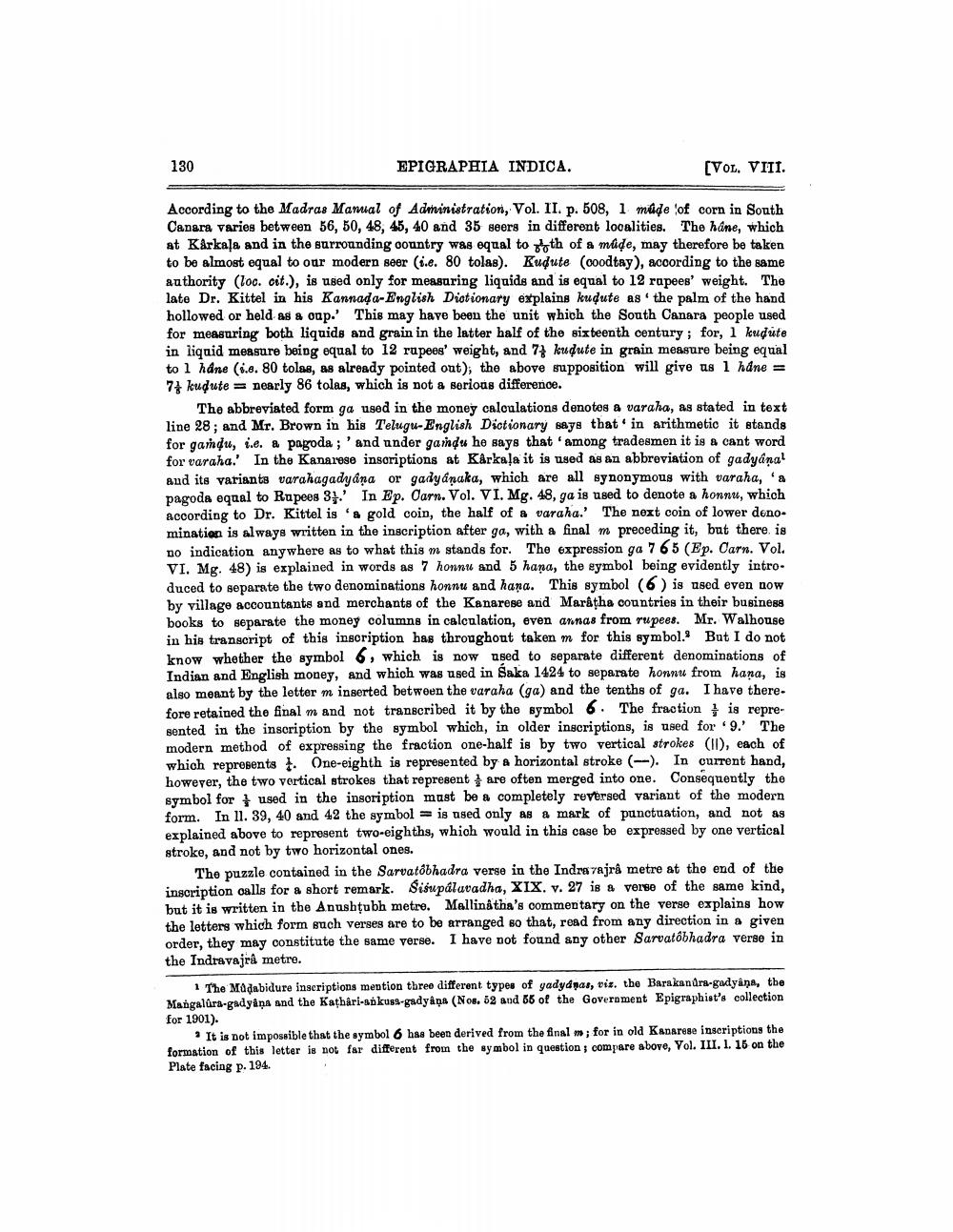________________
130
EPIGRAPHIA INDICA.
[VOL. VIII.
According to the Madras Manual of Administration, Vol. II. p. 508, 1 made of corn in South Canara varies between 56, 50, 48, 45, 40 and 35 seers in different localities. The hane, which at Karkala and in the surrounding country was equal to th of a muḍe, may therefore be taken to be almost equal to our modern seer (i.e. 80 tolas). Kudute (coodtay), according to the same authority (loc. cit.), is used only for measuring liquids and is equal to 12 rupees' weight. The late Dr. Kittel in his Kannada-English Dictionary explains kudute as the palm of the hand hollowed or held as a cup.' This may have been the unit which the South Canara people used for measuring both liquids and grain in the latter half of the sixteenth century; for, 1 kudute in liquid measure being equal to 12 rupees' weight, and 73 kudute in grain measure being equal to 1 hane (.e. 80 tolas, as already pointed out); the above supposition will give us 1 håne = 7 kudute = = nearly 86 tolas, which is not a serious difference.
The abbreviated form ga used in the money calculations denotes a varaha, as stated in text line 28; and Mr. Brown in his Telugu-English Dictionary says that in arithmetic it stands for gamdu, i.e. a pagoda; ' and under gandu he says that among tradesmen it is a cant word for varaha. In the Kanarese inscriptions at Karkala it is used as an abbreviation of gadyana1 and its variants varahagadyana or gadyánaka, which are all synonymous with varaha, 'a pagoda equal to Rupees 3.' In Ep. Carn. Vol. VI. Mg. 48, ga is used to denote a honnu, which according to Dr. Kittel is a gold coin, the half of a varaha.' The next coin of lower denomination is always written in the inscription after ga, with a final m preceding it, but there is no indication anywhere as to what this m stands for. The expression ga 765 (Ep. Carn. Vol. VI. Mg. 48) is explained in words as 7 honnu and 5 hana, the symbol being evidently introduced to separate the two denominations honnu and hana. This symbol (6) is used even now by village accountants and merchants of the Kanarese and Maratha countries in their business books to separate the money columns in calculation, even annas from rupees. Mr. Walhouse in his transcript of this inscription has throughout taken m for this symbol. But I do not know whether the symbol 6, which is now used to separate different denominations of Indian and English money, and which was used in Saka 1424 to separate honnu from hana, is also meant by the letter m inserted between the varaha (ga) and the tenths of ga. I have therefore retained the final m and not transcribed it by the symbol 6. The fraction is represented in the inscription by the symbol which, in older inscriptions, is used for 9.' The modern method of expressing the fraction one-half is by two vertical strokes (II), each of which represents. One-eighth is represented by a horizontal stroke (-). In current hand, however, the two vertical strokes that represent are often merged into one. Consequently the symbol for used in the inscription must be a completely reversed variant of the modern form. In 11. 39, 40 and 42 the symbol is used only as a mark of punctuation, and not as explained above to represent two-eighths, which would in this case be expressed by one vertical stroke, and not by two horizontal ones.
The puzzle contained in the Sarvatôbhadra verse in the Indra vajra metre at the end of the inscription calls for a short remark. Sisupalavadha, XIX. v. 27 is a verse of the same kind, but it is written in the Anushṭubh metre. Mallinatha's commentary on the verse explains how the letters which form such verses are to be arranged so that, read from any direction in a given order, they may constitute the same verse. I have not found any other Sarvatôbhadra verse in the Indravajra metre.
1 The Madabidure inscriptions mention three different types of gadydpas, viz. the Barakandra-gadyana, the Mangalûra-gadyana and the Kathari-ankusa-gadyana (Nos. 52 and 55 of the Government Epigraphist's collection for 1901).
It is not impossible that the symbol 6 has been derived from the final m; for in old Kanarese inscriptions the formation of this letter is not far different from the symbol in question; compare above, Vol. III. 1. 15 on the Plate facing p. 194.




